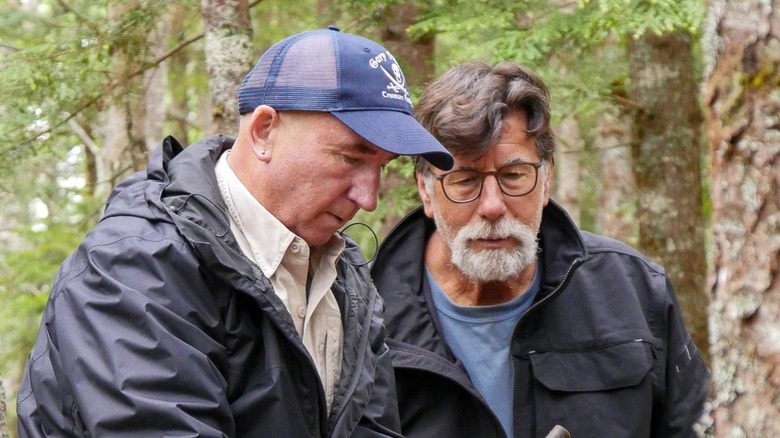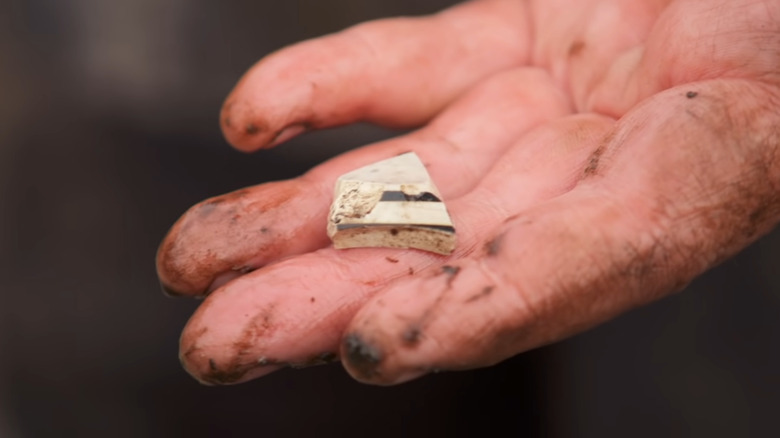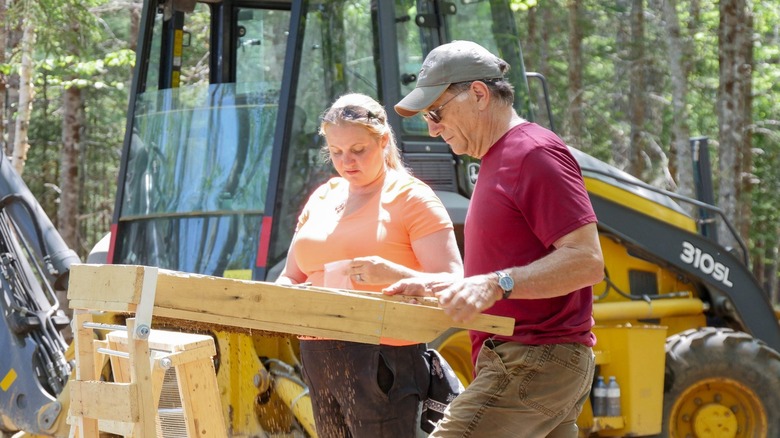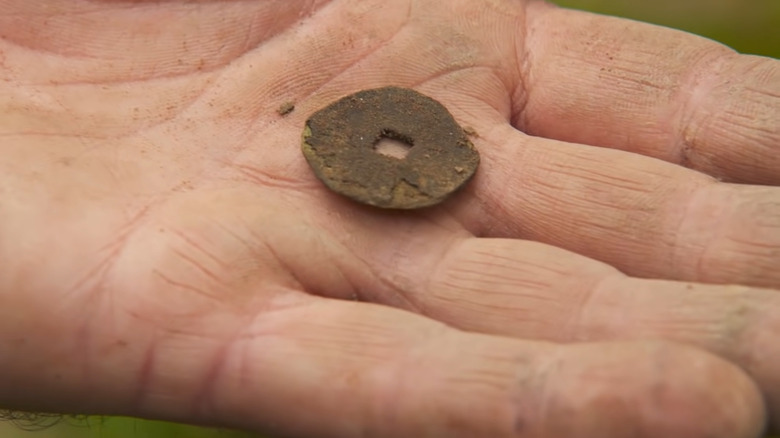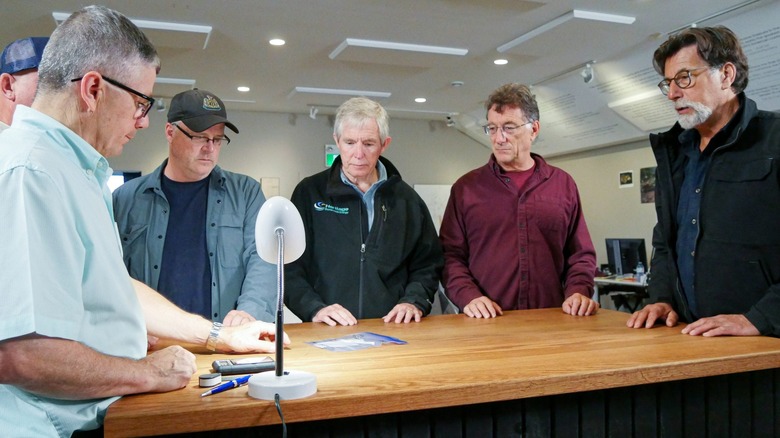The Curse Of Oak Island Season 11: The 5 Biggest Discoveries In Episode 1
The Season 11 premiere of "The Curse of Oak Island" debuted on History last night, delivering some of the most exciting discoveries the team has ever recorded while scouring the Nova Scotian island for the lost bounty. Though Rick, Marty Lagina, and the rest of the Oak Island crew have found treasure frequently over the past decade, the most recent artifacts they've uncovered helped to strengthen certain theories that could end the search once and for all.
From evidence of secret orders and roguish British explorers to coins from a nation never before implicated in the Oak Island mystery, Season 11, Episode 1, "On the Money" will surely go down as one of the most exciting in recent memory. Before the Lagina family makes yet another massive mark on the deadly history of Oak Island, fans have a lot to unpack. Let's dig in and look at some of the biggest findings of the season so far.
Unusual red earthenware at Lot 5 could prove settlements from the early 1600s
Shortly after the start-of-year meeting with the various scientific contributors to the Lagina brothers' Oak Island search, we see the archaeological team — led by Laird Niven — begin its foray into the circular depression on Lot 5. Though most of the obviously man-made additions to the forested location can be attributed to its late owner and custodian, Robert Young, the team has suspicions that he merely contributed to a centuries-old project.
While searching for a foundational wall (that would prove the depression was, in fact, part of a man-made structure that predates the 1760s lot division) and investigating rocks Young left behind, archaeologists Jamie Kouba and Fiona Steele found red earthenware (redware for short). An alternative to stoneware, redware was a type of pottery manufactured and commonly used throughout Europe and North America between the 17th and 18th centuries.
This particular shard of redware found at the site strikes Niven as particularly interesting, as the purple and black glaze appears "unusual." He tells producer Jack Begley, "[Archaeologists] see a lot of coarse earthenware... so when we can't recognize [the time period it belongs to], we immediately wonder if it's earlier." (Niven later describes it as "utilitarian pottery" that wouldn't have changed much over time). When Begley asks how early it could be from, Niven estimates generally that it could have been from the 1600s — which may prove settlers lived near the area before the discovery of the money pit. Needless to say, the discovery left Rick Lagina mystified.
Sonic drilling almost brings the search to an end
While the archaeologists investigated the depression at Lot 5, another team — led by geologist Terry Matheson — began their first sonic drilling operation of the year near the so-called "garden shaft." By drilling six-inch boreholes and examining the nature of extracted earthen material (taken from various depths ranging between 80-120 feet below surface), the team hoped to gain a better understanding of the natural terrain — and hopefully discover the original money pit in doing so.
This particular borehole (dubbed B.5N-13) yields initially promising results. At a depth of 109 feet, they extract evidence of what they describe to be a "soft area," a portion of Earth made up of slushy natural material. According to historian Charles Barkhouse — as well as an enthusiastic Alex Lagina — such an area could indicate that B.5N-13 is near the original money pit, potentially also confirming the existence of a cavern that collapsed in the 1800s. Surveyor Steven Guptill is quick to point out that B.5N-13 is less than five feet away from the discovery sites of precious metals.
Unfortunately, an extraction from 119 feet (revealing nothing but further limestone and hard sediment) seemingly dashes any hopes that the team's first drilling location had been a lucky one. Later, however, they uncover earth from another borehole (DN-12) within the treasure-zone at 97.5 feet, which indicates the presence of a collapsed chamber.
A mysterious metal object could validate a popular Oak Island conspiracy theory
After discovering the unusual redware at Lot 5, the archaeological team uses a metal detector to search the area for other potential artifacts. Before long, they uncover a smartphone-sized metal object encased in hard earth, which Marty Lagina estimates could be a metal latch that was once connected to a cellar or trap door. The team begins to speculate excitedly that whatever door this object came from could have been hiding the money pit.
The metal artifact is taken to the Interpretive Center, where archaeometallurgist Emma Culligan performs a CT scan to determine its exact shape and appearance beneath the hardened earth. Based on the imaging, Laird Niven comes to the conclusion that it's actually a river spike, though he qualifies that "functionally, you could use [it] for anything." The absence of manganese leads the team to believe it's pre-1840s in origin, but Culligan and Niven have something far more interesting up their sleeve.
Niven had previously had the chance to analyze artifacts from the birthplace of Sir William Phips, an English treasure hunter at the center of one of the key Oak Island theories. To put it very simply, Phips is said to have hidden the Oak Island treasure after looting a shipwrecked Spanish galleon. Niven and Culligan assert that, while the river spike doesn't match anything else they've uncovered during their search, it closely matches what they studied from Phips' birthplace.
Drowned debris sparks intrigue for the Oak Island crew
As the rest of the team searches Lot 5 for possible metal objects (or continues the sonic drilling operation at DN-12), Jack Begley and Alex Lagina join with diver Tony Sampson and underwater imaging expert Ken Deboer to investigate a body of water to the north of Oak Island, where it has been theorized a man-made structure once resided. Due to provincial regulations, nothing found by Sampson or Deboer can be retrieved to be studied, though whatever they do lay eyes on can be included in the application for a special permit to excavate at a later time.
While searching the floor, Sampson finds a variety of sunken objects of yet unknown origin. He's able to identify a one-foot-long hand-carved plank of timber (which could support the existence of a dam), pottery marked with blue designs, the remains of a clay sailor's pipe, and what appears to be a coin — the design of which bears passing resemblance to a 1,000-year-old Chinese coin found by Begley and Gary Drayton in 2020 (Season 8). Those present wonder if the debris' similarity to objects on land could imply that a shipwreck took place nearby, or that these items belong to settlers that inhabited the island at the same time as the money pit.
Four coins widen the scope of the Oak Island mystery, potentially tying it to the Knights Templar
Looper readers have likely heard of the Knights Templar before. Whether looming in the shadows of the "Assassin's Creed" series or appearing in the Nicolas Cage flick "National Treasure," the mysterious historical order has long been a magnet for conspiracy theories. One of these theories postulates that they are also responsible for the Oak Island money pit.
Though this remains but one theory frequently revisited on "The Curse of Oak Island," the discovery of more Roman coins arguably strengthens the mystery's connection to the infamous Roman Catholic militia. Having found half of a coin a year earlier within the bounds of Lot 5, Marty Lagina and metal detection expert Gary Drayton managed to uncover two more, each from vastly different time periods. The first was dated by numismatist Sandy Campbell between 100-300 A.D.; the second, bearing the portrait of an unknown male, is more than 2,000 years old and is likely the oldest coin ever found on Oak Island.
The team also came across two other coins that — while similar in appearance to the Roman denominations — came from entirely different parts of the world. One, a British coin from the Tudor period (1500s) bearing a portcullis on one side, could lend more credence to the Sir William Phips theory. The other, however, is estimated by Campbell to be a 6th, 7th, or 8th-century Indian coin — the first from the country to be discovered on Oak Island. Now having found coins of Roman, English, Indian, and Chinese descent, Marty Lagina theorizes that such an ancient treasure could contain currency from many different locations and time periods.
